|
|
BMW 3-Series (E90)
Debut: 2005
Maker: BMW
Predecessor: 3-Series E46 |
|
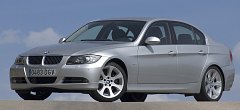 Everybody
in
the class wants to beat BMW 3-Series. With an astonishing 528,000
units sold in 2003, it is not only the best seller in the class but
also by far the most important model for BMW, accounting for 57% of
the brand's total sales. Everybody
in
the class wants to beat BMW 3-Series. With an astonishing 528,000
units sold in 2003, it is not only the best seller in the class but
also by far the most important model for BMW, accounting for 57% of
the brand's total sales.
The first
3-Series, codenamed E21, was born in 1975. It evolved to E30 in 1982,
E36 in 1990, E46 in 1998 and E90 recently. The latest 3-Series grows
slightly bigger again, being 49 mm longer, 78 mm wider and 9 mm
taller than E46. Wheelbase has been stretched by 35 mm, adding 25
desperately needed millimeters to rear legroom. There is also more
shoulder room for all occupants. However, rear headroom is slightly
reduced, limiting its occupants to no more than 6 feet tall. This is
to ensure the 3-Series won't steal sales from the 5-Series. But with
another 7 years or so lying ahead, can it fend off the competition
from the roomier next generation Mercedes C-class, Audi A4 and Alfa
Romeo 159 ?
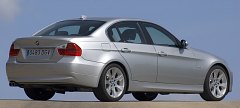 Another
worrying thing is styling. Journalists described the new 3-Series as
the least radical design from Chris Bangle, which sounds a good news.
But is it pretty? The answer is definitely “no” to me. The
problem lies not only on the imposing double-kidney grille and
eagle-eyes headlamps, but also the unbalanced proportion. More
disappointing is the cabin: following the 7 and 5-Series, the new
3-Series has replaced BMW's traditional driver-oriented dashboard
with an ugly, camel-shaped twin-binnacle dashboard. This is simply
equivalent to taking away the jewel from the crown and replace it
with a stone. We can never understand this, and we can never forgive
Chris Bangle. Another
worrying thing is styling. Journalists described the new 3-Series as
the least radical design from Chris Bangle, which sounds a good news.
But is it pretty? The answer is definitely “no” to me. The
problem lies not only on the imposing double-kidney grille and
eagle-eyes headlamps, but also the unbalanced proportion. More
disappointing is the cabin: following the 7 and 5-Series, the new
3-Series has replaced BMW's traditional driver-oriented dashboard
with an ugly, camel-shaped twin-binnacle dashboard. This is simply
equivalent to taking away the jewel from the crown and replace it
with a stone. We can never understand this, and we can never forgive
Chris Bangle.
The cabin has
another problem: visual quality. It looks not only uglier, but also
more plasticky and therefore less expensive than the E46. Strangely,
the plastic materials employed are actually of higher grade, but the
convex-concave shape of the dashboard generates more light
reflection, hence amplifying the sense of plasticky. The pronounced
assembly gaps between different plastic parts also downgrade the
quality feel. The same goes for the very fake wood trim – unless
you are King of the Jungle, you'd better to avoid wood trim and
choose the aluminum trim instead.
 We have enough
disappointment up to this point. Fortunately, starting from here
everything is more positive. The E90 follows the footprints of its
predecessors to be an exciting driver's car, thanks to a balanced
chassis, fine tuning and excellent powertrains. We have enough
disappointment up to this point. Fortunately, starting from here
everything is more positive. The E90 follows the footprints of its
predecessors to be an exciting driver's car, thanks to a balanced
chassis, fine tuning and excellent powertrains.
The chassis of
E90 is 25% stiffer than E46's yet without any increase of kerb
weight. What it cannot improve is the already perfect 50:50 weight
distribution. Yes, BMW 3-Series is still the only car in the class
and one of the few front-engined cars in the world achieving 50:50
balance. Unlike rivals, BMW is willing to sacrifice cabin space in
return for good handling. Therefore it pushes the engine accompany
with the cabin rearward, resulting in better balance. Besides, it
places the battery at the boot and deliberately uses steel to
construct the rear suspensions (while front suspensions and subframe
are aluminum). All these contribute to the perfect chassis balance.
The front
suspensions are again MacPherson struts, but the rear switches from
Z-axle (which can be dated back to E36) to a new 5-link suspension
sharing with 1-Series. Overall, the 3-Series has 40% components
shared with the 1-Series. This include engines and gearboxes of
course.
BMW's inline-6
engine is world famous, but it is no longer as powerful as rivals
(e.g. the 272hp Mercedes 3.5 V6 and 255hp Audi 3.2 V6, not to mention
Honda Legend's 300hp 3.5 V6). Surprisingly, BMW decided not to
increase capacity, but to keep its straight-6 at 2.5 litres and 3.0
litres. It seeks extra power by improving efficiency. In my opinion,
the R6 is the most sophisticated mass production engine in the world,
employing a lot of advanced technologies: Bi-Vanos VVT, 3-stage
variable intake manifolds, Valvetronic, and the world's first
magnesium-aluminum crankcase. The latter makes it undercutting the
outgoing engine by 10 kg. In 3.0 litre form, it produces 258
horsepower (compare to the previous 231hp) yet drinks 12% less fuel
than the old engine.
However, what
makes the 3-Series a half-million seller is not just the straight-6,
but also a full range of world class engines, including the
entry-level 2.0-litre Valvetronic 4-pot (150hp) and the 2.0-litre 16V
turbo diesel (163hp), which is very popular in Europe. The current
218hp 3.0-litre turbo diesel inline-6 will also find home at the new
3-Series, and it could get another power boost. All engines work in
companion with a new 6-speed manual or 6-speed automatic gearbox.
On
the Road
 Bad
taste styling aside, the 3-Series is everything car enthusiasts want.
It is fast and genuinely fun to drive. Its handling exceeds everyone
else in the class by a convincing margin. Bad
taste styling aside, the 3-Series is everything car enthusiasts want.
It is fast and genuinely fun to drive. Its handling exceeds everyone
else in the class by a convincing margin.
Unquestionably,
the 3-litre straight-6 is a masterpiece, being superbly smooth, eager
and linear across a very wide band. It might not be as torquey as its
larger rivals, but from 2000 rpm it already delivers respectable
punch, and no one else can be so eager to spin to 7000 rpm redline.
No coarse sound, just a characterful music that only BMW's inline-6
can make.
What
it lacks in torque is compensated with 6 gear ratios, a slick manual
gearshift and a relatively lightweight body. 330i can easily squeeze
into the 6 second barrier for 0-60 mph acceleration (note: Car and
Driver clocked 5.6 seconds), faster than anything else in the class.
The 330i is also one of the few 3.0-litre cars that can reach an
electronic limited 155 mph (250 km/h). You can't help praising its
efficiency.
The
3-Series is the only car in the class genuinely communicates with the
driver. Its steering is precise and feelsome. Its throttle, clutch
and brake pedals are accurate and nicely weighted. Its gearbox shifts
crisply. All controls encourage the driver to exploit maximum
performance from the car. BMW must have spent a lot of time and
effort in tuning the controls.
The
chassis is also a source of wonder. Incredible chassis stiffness
gives the E90 simultaneously higher precision in body control and
more supple damping while reducing NVH to the cabin. Ride quality is
still firmer than Mercedes, but body control is obviously out of
reach by its rivals. However, most outstanding is the superb balance
of the chassis. The 3-Series feels small and light to steer. It
reacts instantly to steering input and is easy to steer by throttle
once you switch off the DSC stability control. Nose-heavy cars can
never display such pure control.
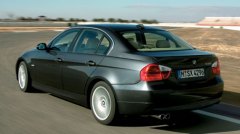 Nevertheless,
the chassis is not without flaws: when it approach cornering limit,
it displays a little more understeer than good drivers desired. In
fact, BMW deliberately tuned the chassis like this to please the
majority of customers. For those pursuing ultimate driving fun, they
can choose the optional Sport suspension package, which include 15mm
lower ride height and stiffer suspensions. Ride quality suffers a
little, but the package eliminates understeer and body roll. Nevertheless,
the chassis is not without flaws: when it approach cornering limit,
it displays a little more understeer than good drivers desired. In
fact, BMW deliberately tuned the chassis like this to please the
majority of customers. For those pursuing ultimate driving fun, they
can choose the optional Sport suspension package, which include 15mm
lower ride height and stiffer suspensions. Ride quality suffers a
little, but the package eliminates understeer and body roll.
Another
flaw of the E90 is the Active Steer, which was first introduced in
the 5-Series. After a year, most car journalists are still
unconvinced with its unpredictable variable steering ratio. So it is
better not to waste money on this optional equipment. In fact, the
standard hydraulic power steering is so good that who bother to have
Active Steer?
Overall
speaking, the 3-Series once again pull away from its Mercedes and
Audi rivals. To driving enthusiasts, it is the best choice of the
class, at least for the time being. But prettier and more powerful
cars like Alfa 159 and Lexus IS could threaten its position in the
near future. We are looking forward to see a close fight.
|
| The
above report was last updated on 7 Apr 2005. All Rights Reserved. |
|
The sophisticated R6 engine
|
Note: the
internal codename of R6 was later known as N52
 BMW's
M54
inline-6 engine won praises all over the world. But the new R6 engine
is better in every way, no matter power, weight or fuel consumption.
In 2.5 and 3.0-litre form, it produces 218hp and 258hp respectively,
compare with the old engine's 192hp and 231hp. This translate to
86-87hp per litre, the highest specific output of the class – we
talk about mass production naturally aspirated engines of course. BMW's
M54
inline-6 engine won praises all over the world. But the new R6 engine
is better in every way, no matter power, weight or fuel consumption.
In 2.5 and 3.0-litre form, it produces 218hp and 258hp respectively,
compare with the old engine's 192hp and 231hp. This translate to
86-87hp per litre, the highest specific output of the class – we
talk about mass production naturally aspirated engines of course.
The outstanding
efficiency is contributed by several technologies. Like the outgoing
engine, it has double Vanos continuously variable valve timing at all
camshafts. What's new to the inline-6 is Valvetronic system, which
eliminates throttle butterflies by varying valve lift according to
throttle pedal. This reduces pumping loss at partial throttle, thus
allows the R6 to drink 12% less fuel than the old engine.
In the past,
the first generation Valvetronic used in BMW's V8 and inline-4
engines were seen as a fuel-reducing means rather than a
power-enhancing design, although it is actually a variable valve lift
system (think of Honda's VTEC). This was because the Valvetronic
mechanism was heavy, limiting the revability of the engine. In the
new R6 engine, the second generation Valvetronic employs aluminum
parts to reduce moving mass. The camshafts are also converted to
hollow type to save some 1.2 kg. This allow its variable lift
function to excel at high rev, pushing maximum rev from 6500 rpm to
7000 rpm. This account for most of the power gain.
The R6 produces
no more maximum torque than M54, but the torque curve is improved by
using a 3-stage resonance variable intake system instead of the
outgoing 2-stage system. For example, the 3.0 engine used to produce
its maximum torque at 3500-4750 rpm. The new engine becomes 2500-4000
rpm.
Another advance
is the use of electric water pump instead of engine-driven pump. It
can save up to 2kW or 2.7 horsepower.
However, the
biggest advance over M54 is weight reduction. Weighing 161kg only, it
is claimed to be the world's lightest 6-cylinder engine, although
Audi's 3.2 V6 is not far away at 169.5 kg. Contributing to the weight
saving is the use of magnesium cam cover and the world's first
magnesium-aluminum hybrid crankcase. The crankcase consists of 2
parts: magnesium housing and aluminum insert. The magnesium housing
contains the oil channels and provides mountings for peripherals such
as gearbox and alternator. The aluminum insert is employed to handle
the high temperature and mechanical stress that magnesium cannot cope
with. Despite of the addition of Valvetronic, the R6 is 10 kg lighter
than M54.
The only
weakness of R6 is the lack of space for enlargement. The 3.0 engine
has a 85mm bore and 88mm stroke, while distance between bore center
is just 91mm. That nearly rule out the possibility for enlargement.
Most of its competitors now employ V6 engines displacing between 3.2
and 3.5 litres. Can the R6 find ways to increase power and, more
crucially, torque in the future? or switch to turbocharging? I will
be very interested to see.
|
| The
above report was last updated on 7 Apr 2005. All Rights Reserved. |
|
3-Series Coupe (E92) and 335 engine
|
 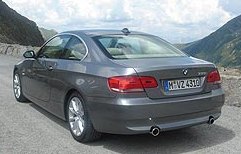
Well, the new 3-Series
Coupe may
be not as beautiful as Alfa Brera or Audi TT, but it is definitely a
vast improvement from the ugly 3-Series sedan. Its side profile is
cleaner, its front end more elegant (thanks to the new grille,
headlamps, bumper and a 3-dimensional bonnet) and its new taillights
far easier to the eyes than those ugly units in the sedan. It is the
best Chris Bangle design to date, and together with 6-series it proves
that Bangle draw coupes better than sedans.
As always, 3-Series Coupe is mechanically nearly identical to its sedan
sister, unlike many rivals which use shorter wheelbase and different
chassis for the coupe versions. Cost is one reason, but equally
important is that BMW wants to offer 4-people accommodation and comfort
close to the sedan. Remember, the root of 3 Coupe traces back to the
original 3-Series E21, which was strictly a 2-door sedan. It was joined
by a 4-door version since the second generation (E30), and then itself
finally evolved to 3-Series Coupe in the third generation (E36). From
the very beginning, 3 Coupe has been a 2-door version of the sedan as
well as a genuine 4-seater. The latest car is no exception. It shares
the same 2760 mm wheelbase with the sedan and its overall length is
only 60 mm longer due to the extended overhangs necessary for pretty
styling. Its windscreen and rear window are angled slightly faster. It
employs 2 large doors with frameless windows, surrounded elegantly by
chromed stripes. Inside, the cabin is let down by the same odd
dashboard (too expensive to engineer its own item). Rear seats become 2
individual seats, each capable of sitting 6-foot-plus passenger behind
a front occupant of similar height. Apart from 3 Coupe, which coupe can
do that?
 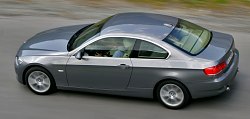 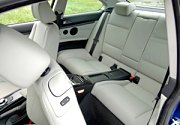
Engine by engine, the Coupe is no lighter than the Sedan, so
performance is virtually identical. However, its handling is slightly
superior, thanks to a 20% increase of chassis rigidity (due to the loss
of rear doors), a 12mm lower ride height and stiffer suspension
setting. Considering the sedan is already an excellent driver's car,
the coupe is even more appealing. Its near perfect weight distribution
and rear-drive architecture are elements that most rivals can only dream of.
Its well-judged tuning and mechanical integrity are beyond the approach
of most rivals.
335i engine
The biggest news for the
3-Series Coupe is the introduction of the 335i engine, although
undoubtedly it will be applied to the sedan and most other BMW series
soon. While the name of the car suggests a 3.5-liter V8, in fact its
heart is a twin-turbo 3.0-liter straight-6. Codenamed N54, it is a
development from the normally aspirated 3.0-liter unit (now updated to
an astonishing 272hp and is called N53). This is BMW's first
turbocharged petrol engine since the 1980 745i. For a quarter of a
century, the company insisted to use only normally aspirated engines in
order to deliver the best linearity and throttle response to delight
its demanding drivers. Nevertheless, as the technology of turbochargers
progressed quickly in recent years, and the market / legislation calls
for more efficient engines, turbocharging is once again put on the map
of BMW.
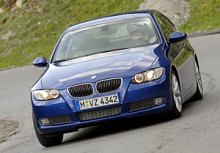 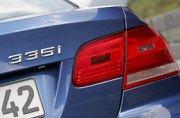 
The
N54 engine employs a pair of small turbochargers to boost a very light
pressure - only 0.4 bar. Therefore it produces "only" 34 more
horsepower than the updated normally aspirated version, or a total of
306 horsepower at 5800 rpm. However, the small turbos in addition to
the most sophisticated piezo direct gasoline injection (faster response
than regular solenoid injectors) allows a normally aspirated-like
compression ratio of 10.2:1 and a very strong torque curve, with a peak
of 295 lbft (up 63 lbft) running continuously from 1300 rpm all the way
to 5000 rpm. This made the variable intake manifolds and Valvetronic
redundant, therefore discarded. The higher mechanical and thermal
stress called for a negative change though: the magnesium outer
crankcase is replaced by a conventional aluminum block with cast iron
liners. At 190 kilograms the twin-turbo N54 is 28 kg heavier than the
magnesium normally aspirated engine. Audi S4's 344hp 4.2-liter V8 is
only 5 kilos heavier. Nevertheless, sticking with 6 cylinders allow the
BMW engine to return remarkable frugality - 29.7 mpg according to EU
combine cycle. Audi manages only 21.2 mpg.
On the road, the 335i engine is a gem. It feels like a large capacity
V8 instead of a turbocharged six, thanks to the absence of turbo lag,
the astonishing bottom-end tractability and the quick throttle
response. You will be difficult to sense that it is actually a turbo
engine. Yes, when approaching the 7000 rpm redline it could feel
slightly breathless, and at most rev the engine produces a deeper,
bassier noise than the normally aspirated version. That's the only
indication of its real identity.
While 0-60 mph in 5.2 seconds may not sound too much improvement from
330i, 335i has far superior real world performance due to its strong
torque curve. It could be even quicker than an E46 M3 if both drivers
are driving at 90 percent effort - think of those 343 horsepower
releases at a heady 7900 rpm and only 269 lbft of torque is available
at no earlier than 4900 rpm. Combining "junior M3" performance and the
frugality and civility of regular 3-series coupes, BMW's decision to
return to turbocharging can't more more correct.
|
| The
above report was last updated on 21 Aug 2006. All Rights Reserved. |
|
335d Coupe
|
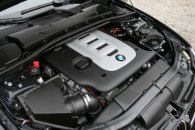 We
used to think the twin-turbo petrol 335i Coupe is the perfect coupe to
satisfy our requirements for fun and practicality simultaneously. But
many motoring journalists keep telling us that the diesel 335d Coupe is
even better. On paper, the diesel version takes longer time to reach 60
mph, although still in an impressive 5.9 seconds. It carries 45 extra
kilograms compare with a 6-speed manual 335i Coupe. Moreover, it does
not offer any manual gearbox to please those who like to shift by
themselves. It also costs a little more money to purchase. So how can
it better the petrol version ? We
used to think the twin-turbo petrol 335i Coupe is the perfect coupe to
satisfy our requirements for fun and practicality simultaneously. But
many motoring journalists keep telling us that the diesel 335d Coupe is
even better. On paper, the diesel version takes longer time to reach 60
mph, although still in an impressive 5.9 seconds. It carries 45 extra
kilograms compare with a 6-speed manual 335i Coupe. Moreover, it does
not offer any manual gearbox to please those who like to shift by
themselves. It also costs a little more money to purchase. So how can
it better the petrol version ?
The answer lies on the engine. This 3-liter inline-6 with variable
twin-turbocharger was first introduced to 535d in the form of 272
horsepower, but later improved to 286 horsepower at 4400 rpm. The
clever combination of two different size turbos – the smaller one for
low rpm and the larger one for high rpm – and the smooth transition
between the two turbos enable an almost instantaneous response and
virtually free of turbo lag. The engine is so efficient, just 20hp
short of the petrol 335i and it returns superior fuel consumption at
37.7 mpg. More telling is the tremendous torque curve which peaks at
428 lbft from 1750 rpm to 2250 rpm. No other 6-cylinder turbo diesel
engines are so punchy !
 With so much torque, no
wonder the 335d Coupe feels faster than its petrol brother in real
world. We used to think 335i effortlessly quick, but 335d sets new
standard again. So effortless that there is no point to insist a manual
gearbox. The 6-speed automatic is both silky smooth and responsive thus
is a perfect companion with the diesel engine. The engine itself is
also very refined. Apart from a slight diesel-like vibration at cold
startup, you are not easy to tell whether it is a diesel or a petrol
engine. With so much torque, no
wonder the 335d Coupe feels faster than its petrol brother in real
world. We used to think 335i effortlessly quick, but 335d sets new
standard again. So effortless that there is no point to insist a manual
gearbox. The 6-speed automatic is both silky smooth and responsive thus
is a perfect companion with the diesel engine. The engine itself is
also very refined. Apart from a slight diesel-like vibration at cold
startup, you are not easy to tell whether it is a diesel or a petrol
engine.
Compare with an automatic 335i, the 335d gained only 30kg over its
front axle. This makes the steering heavier and the ride a little
firmer at low speed, but otherwise it handles and rides as brilliantly
as 335i.
Back to our question, is 335d better than 335i ? that depends on your
preference. If you prefer effortless driving style, 335d will be the
better choice. If you prefer to play with engine rev and gearshift and
enjoy the best possible ride and handling, then 335i will be the
ultimate choice.
|
| The
above report was last updated on 3 May 2007. All Rights Reserved. |
|
3-Series Cabriolet
|
 In
my opinion, BMW 3-Series Cabriolet should have stuck with traditional
soft roof. Switching to folding metal roof added complexity and a
weight penalty of 200 kilograms on the top of the equivalent Coupe.
This hampered its performance and civilized its handling. No wonder in
its first road test event, BMW offered journalists to test only the
most powerful model, 335i Cabriolet. As predicted, most journalists
described the car felt slower than 335i Coupe, but the tremendous
bottom-end and mid-range torque from the twin-turbo direct injection
six reduced the damage to the minimum. Try a 330i or 325i instead and
do you think the journalists will give the same favourable comments ? In
my opinion, BMW 3-Series Cabriolet should have stuck with traditional
soft roof. Switching to folding metal roof added complexity and a
weight penalty of 200 kilograms on the top of the equivalent Coupe.
This hampered its performance and civilized its handling. No wonder in
its first road test event, BMW offered journalists to test only the
most powerful model, 335i Cabriolet. As predicted, most journalists
described the car felt slower than 335i Coupe, but the tremendous
bottom-end and mid-range torque from the twin-turbo direct injection
six reduced the damage to the minimum. Try a 330i or 325i instead and
do you think the journalists will give the same favourable comments ?
 Well,
at least the chassis is very stiff. Among the added kilograms, about a
third is spent to reinforce the chassis, which is 50 percent stiffer in
torsion than the last generation Cabriolet. The roof mechanism is also
well built. It comprises of 3 pieces like Volvo C70, so it does not
require raking the windscreen to reduce the size of roof panel, or
lengthening the boot to accommodate it. With the roof up, the new
Cabriolet looks almost the same as the Coupe. It even provides the same
large glass area to lighten the cabin ambience. Well,
at least the chassis is very stiff. Among the added kilograms, about a
third is spent to reinforce the chassis, which is 50 percent stiffer in
torsion than the last generation Cabriolet. The roof mechanism is also
well built. It comprises of 3 pieces like Volvo C70, so it does not
require raking the windscreen to reduce the size of roof panel, or
lengthening the boot to accommodate it. With the roof up, the new
Cabriolet looks almost the same as the Coupe. It even provides the same
large glass area to lighten the cabin ambience.
The steel roof takes 22 seconds to open and 23 seconds to close,
considerably faster than Volvo C70. When it is up, it provides very
good noise and thermal insulation – that's the point of building
coupe-cabriolet. When the roof is down, the Cabriolet suppresses wind
buffeting very well. This car demonstrates extremely high standard of
finish like any other BMWs.
 The boot can swallow 350
liters of luggage with the roof is up, or reduces to 210 liters when
the roof is down. Both figures are average to the class. Unfortunately,
with the roof in the boot, it is difficult to access luggage through
the narrow opening. The boot can swallow 350
liters of luggage with the roof is up, or reduces to 210 liters when
the roof is down. Both figures are average to the class. Unfortunately,
with the roof in the boot, it is difficult to access luggage through
the narrow opening.
The front half of the
cabin remains unchanged from the 3-Series Coupe. Inevitably, the rear
passenger space gets narrower and shorter due to the roof mechanism and
chassis strengthening. The seatback is more upright yet legroom is
reduced. This place is better suited to children or short adults.
However, the problem of this car does not lie in practicality, but the
fact that the 3-Series Coupe performs, handles and rides so much
better. Having tried the Coupe, you will be regret to sacrifice all the
finesses for open air motoring.
|
| The
above report was last updated on 5 Feb 2007. All Rights Reserved. |
|
2007 engine upgrade
|
In 2007 the
3-Series had most engines updated. All petrol engines got direct
injection in place of the less efficient Valvetronic to boost output -
318i increased from 129 to 143hp, 320i from 150 to 170hp, 325i from 204
to 218hp, 330i from 258 to 272hp. Four-pot diesel engines received 3rd
generation common-rail injection to boost power as well - 318d
increased from 122 to 143hp and 320d from 163 to 177hp.
Fuel efficiency was lifted also by the "Efficient Dynamics" measures,
including brake energy regeneration, low rolling resistance tires,
on-demand water pump and air conditioning. The four-pot engines also
got auto start stop to boost fuel efficiency in urban driving.
|
| The
above report was last updated on 15 Aug 2009. All Rights Reserved. |
|
2008 facelift
|
 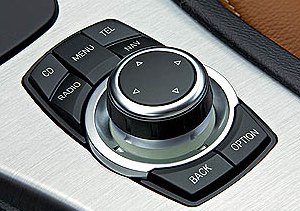
In
July 2008 BMW unveiled the facelifted 3-series saloon and touring.
Although their fascia, bumper, headlamps and bonnet are all reshaped,
they are not much prettier than the original design. Those seeking a
stylish junior executive car will still find Alfa Romeo 159 and Audi A4
more convincing. Inside, the cabin is mostly unchanged. This mean it
still trails Audi and Mercedes for quality. The only significant
upgrade in the cabin is the notorious iDrive control system. Its user
interface now provides 4 additional buttons for faster access to CD,
radio, telephone and air conditioning. Besides, short-cut keys can be
programmed. It finally works ! Now it is easier to use than similar
systems by Audi and Mercedes. Less significant changes include a larger
color LCD screen and BMW’s new in-car internet access system called
ConnectDrive.
Like most facelifts, this one alters little the chassis. The only
change worth mentioning is a 24mm wider rear track on the 6-cylinder
cars, which helps handling a bit. Most engines are carried over
unchanged, except the 3.0-liter turbo diesel that serves 330d, whose
power increased from 231hp to 245hp thanks to the use of 1800 bar
common-rail injection. Brilliantly, its fuel consumption also improves
from 46.3 to 49.6 mpg. This is unbelievably economical for a car
capable of going from 0-60 mph in 5.8 seconds (claimed) and topping 155
mph (electronic regulated) !
On the road, the facelifted 3-Series shows no noticeably difference
from the outgoing car in terms of ride and handling. Admittedly, it
still tops the class and narrowly beats Mercedes C-class in overall
dynamic excellence. In terms of powertrain, performance and fuel
efficiency, there is simply no rivals. What feels a little outdated is
actually its design and packaging.
|
| The
above report was last updated on 24 Oct 2008. All Rights Reserved. |
|
335is Coupe
|
 Although it is
born as a North America-only model, there is no reason why 335is coupe
cannot be offered in Europe and the rest of the world. The conversion
from 335i to 335is is easy. You take the outgoing N54 bi-turbo engine
(now 335i has switched to single-turbo and Valvetronic-equipped N55),
increase its boost pressure, smoothen its intake, install a throatier
exhaust and give it an additional radiator for better cooling, then you
will get 326 horsepower (DIN), or 20 more than 335i. Maximum torque
improves too, from 295 to 332 pound-foot, accessible from a still
respectably wide band between 1500 and 5000 rpm. By remapping the
engine management software, you can even get an overboost to 369 lb-ft
for at most 7 seconds without overheating the engine. The higher tuning
can only happen in the twin-turbo six. In this way, BMW has reshuffled
the roles of N54 and N55. Although it is
born as a North America-only model, there is no reason why 335is coupe
cannot be offered in Europe and the rest of the world. The conversion
from 335i to 335is is easy. You take the outgoing N54 bi-turbo engine
(now 335i has switched to single-turbo and Valvetronic-equipped N55),
increase its boost pressure, smoothen its intake, install a throatier
exhaust and give it an additional radiator for better cooling, then you
will get 326 horsepower (DIN), or 20 more than 335i. Maximum torque
improves too, from 295 to 332 pound-foot, accessible from a still
respectably wide band between 1500 and 5000 rpm. By remapping the
engine management software, you can even get an overboost to 369 lb-ft
for at most 7 seconds without overheating the engine. The higher tuning
can only happen in the twin-turbo six. In this way, BMW has reshuffled
the roles of N54 and N55.
The extra power gives
335is higher performance, of course. We are talking of 0-60 mph in 4.9
seconds instead of 5.2. In other words, it bridges the gap between 335i
and M3. On the road, the deeper resonant of its exhaust note is more
obvious than the performance. Besides, passer-bys will notice the
M-sport aero kits and the new bumpers resembling M3. Suspensions and
brakes are the same as before. Considering how good 335i used to
corner,
BMW found no reasons to upgrade them. Overall, 335is is not a headline
model. It is just a logical application of the same engine powering
740i and Z4 sDrive35is.
|
| The
above report was last updated on 19 Feb 2010. All Rights Reserved. |
| Specifications
|
|
|
|
|
Table 1
|
11
|
12
|
13
|
| General
remarks |
| Layout |
| Chassis |
| Body |
| Length / width / height |
| Wheelbase |
| Engine |
| Capacity |
Valve gears
|
Induction
|
| Other engine features |
| Max power |
Max torque
|
| Transmission |
Suspension layout
|
| Suspension features |
Tires
|
| Kerb weight |
| Top speed |
| 0-60 mph (sec) |
| 0-100 mph (sec) |
|
| 320i sedan (2005) |
Front-engined, RWD
|
| Steel monocoque |
Mainly steel
|
| 4520
/ 1817
/ 1424 mm |
| 2760 mm |
| Inline-4 |
| 1995 cc |
DOHC 16 valves, DVVT, VVL (Valvetronic)
|
VIM
|
| - |
150 hp
|
147 lbft
|
| 6-speed manual |
F: strut
R: multi-link
|
| - |
205/55VR16
|
1320 kg
|
137 mph (c)
|
8.5 (c)
|
| - |
|
| 330i sedan (2005) |
Front-engined, RWD
|
| Steel monocoque |
Mainly steel
|
| 4520
/ 1817
/ 1424 mm |
| 2760 mm |
| Inline-6 |
| 2996 cc |
DOHC 24 valves, DVVT, VVL (Valvetronic)
|
VIM
|
| - |
258 hp
|
221 lbft
|
| 6-speed manual |
F: strut
R: multi-link
|
| - |
225/45WR17
|
1450 kg
|
155 mph (limited)
|
5.9 (c) / 5.6**
|
| 15.3** |
|
| 320i sedan (2007) |
Front-engined, RWD
|
| Steel monocoque |
Mainly steel
|
| 4520
/ 1817
/ 1421 mm |
| 2760 mm |
| Inline-4 |
| 1995 cc |
DOHC 16 valves, DVVT
|
VIM
|
| DI |
170 hp
|
155 lbft
|
| 6-speed manual |
F: strut
R: multi-link
|
| - |
205/55HR16
|
1370 kg
|
142 mph (c)
|
7.7 (c)
|
| - |
|
Table 2
|
21
|
22
|
23
|
| General
remarks |
| Layout |
| Chassis |
| Body |
| Length / width / height |
| Wheelbase |
| Engine |
| Capacity |
Valve gears
|
Induction
|
| Other engine features |
| Max power |
Max torque
|
| Transmission |
Suspension layout
|
| Suspension features |
Tires
|
| Kerb weight |
| Top speed |
| 0-60 mph (sec) |
| 0-100 mph (sec) |
|
| 330i sedan (2007) |
Front-engined, RWD
|
| Steel monocoque |
Mainly steel
|
| 4520
/ 1817
/ 1421 mm |
| 2760 mm |
| Inline-6 |
| 2996 cc |
DOHC 24 valves, DVVT
|
-
|
| DI |
272 hp
|
236 lbft
|
| 6-speed manual |
F: strut
R: multi-link
|
| - |
225/45WR17
|
1480 kg
|
155 mph (limited)
|
5.8 (c)
|
| - |
|
| 335i sedan (2007) |
Front-engined, RWD
|
| Steel monocoque |
Mainly steel
|
| 4520
/ 1817
/ 1421 mm |
| 2760 mm |
| Inline-6 |
| 2979 cc |
DOHC 24 valves, DVVT
|
Twin-turbo
|
| DI |
306 hp
|
295 lbft
|
| 6-speed manual |
F: strut
R: multi-link
|
| - |
F: 225/40WR18
R: 255/35WR18
|
1535 kg
|
155 mph (limited)
|
4.9** / 5.0***
|
| 12.1** / 12.3*** |
|
| 330d sedan (2008) |
Front-engined, RWD
|
| Steel monocoque |
Mainly steel
|
| 4520
/ 1817
/ 1421 mm |
| 2760 mm |
Inline-6, diesel
|
| 2993 cc |
DOHC 24 valves
|
VTG turbo
|
| CDI |
245 hp
|
384 lbft
|
| 6-speed manual |
F: strut
R: multi-link
|
| - |
F: 225/40WR18
R: 255/35WR18
|
1535 kg
|
155 mph (limited)
|
6.0*
|
| 15.0* |
|
Table 3
|
31
|
32
|
33
|
| General
remarks |
| Layout |
| Chassis |
| Body |
| Length / width / height |
| Wheelbase |
| Engine |
| Capacity |
Valve gears
|
Induction
|
| Other engine features |
| Max power |
Max torque
|
| Transmission |
Suspension layout
|
| Suspension features |
Tires
|
| Kerb weight |
| Top speed |
| 0-60 mph (sec) |
| 0-100 mph (sec) |
|
| 335i coupe |
Front-engined, RWD
|
| Steel monocoque |
Mainly steel
|
| 4580
/ 1782
/ 1375 mm |
| 2760 mm |
Inline-6
|
| 2979 cc |
DOHC 24 valves, DVVT
|
Twin-turbo
|
| DI |
306 hp
|
295 lbft
|
| 6-speed manual |
F: strut
R: multi-link
|
| - |
F: 225/45WR17
R: 245/40WR17
|
1525 kg
|
155 mph (limited)
|
5.2 (c) / 5.4* / 4.9**
|
12.8* / 12.1**
|
|
| 335d coupe |
Front-engined, RWD
|
| Steel monocoque |
Mainly steel
|
| 4580
/ 1782
/ 1375 mm |
| 2760 mm |
Inline-6, diesel
|
| 2993 cc |
DOHC 24 valves
|
Sequential twin-turbo
|
| CDI |
286 hp
|
428 lbft
|
6-speed automatic
|
F: strut
R: multi-link
|
| - |
F: 225/45WR17
R: 255/40WR17
|
1570 kg
|
155 mph (limited)
|
5.9 (c) / 5.8*
|
13.8*
|
|
| 335i cabriolet |
Front-engined, RWD
|
| Steel monocoque |
Mainly steel
|
| 4580
/ 1782
/ 1384 mm |
| 2760 mm |
Inline-6
|
| 2979 cc |
DOHC 24 valves, DVVT
|
Twin-turbo
|
| DI |
306 hp
|
295 lbft
|
6-speed manual
|
F: strut
R: multi-link
|
| - |
F: 225/45WR17
R: 245/40WR17
|
1735 kg
|
155 mph (limited)
|
5.5 (c)
|
-
|
|
Table 4
|
41
|
42
|
43
|
| General
remarks |
| Layout |
| Chassis |
| Body |
| Length / width / height |
| Wheelbase |
| Engine |
| Capacity |
Valve gears
|
Induction
|
| Other engine features |
| Max power |
Max torque
|
| Transmission |
Suspension layout
|
| Suspension features |
Tires
|
| Kerb weight |
| Top speed |
| 0-60 mph (sec) |
| 0-100 mph (sec) |
|
| 335is coupe |
Front-engined, RWD
|
| Steel monocoque |
Mainly steel
|
| 4580
/ 1782
/ 1375 mm |
| 2760 mm |
Inline-6
|
| 2979 cc |
DOHC 24 valves, DVVT
|
Twin-turbo
|
| DI |
326 hp
|
332 lbft
|
7-speed twin-clutch (DCT)
|
F: strut
R: multi-link
|
| - |
F: 225/45WR17
R: 245/40WR17
|
-
|
155 mph (limited)
|
4.9 (c) / 4.6**
|
11.4**
|
|
|
|
|
| Performance
tested by: *Autocar,
**C&D, ***R&T |
Copyright©
1997-2010
by Mark Wan @ AutoZine
|
|
|
 Everybody
in
the class wants to beat BMW 3-Series. With an astonishing 528,000
units sold in 2003, it is not only the best seller in the class but
also by far the most important model for BMW, accounting for 57% of
the brand's total sales.
Everybody
in
the class wants to beat BMW 3-Series. With an astonishing 528,000
units sold in 2003, it is not only the best seller in the class but
also by far the most important model for BMW, accounting for 57% of
the brand's total sales.  Another
worrying thing is styling. Journalists described the new 3-Series as
the least radical design from Chris Bangle, which sounds a good news.
But is it pretty? The answer is definitely “no” to me. The
problem lies not only on the imposing double-kidney grille and
eagle-eyes headlamps, but also the unbalanced proportion. More
disappointing is the cabin: following the 7 and 5-Series, the new
3-Series has replaced BMW's traditional driver-oriented dashboard
with an ugly, camel-shaped twin-binnacle dashboard. This is simply
equivalent to taking away the jewel from the crown and replace it
with a stone. We can never understand this, and we can never forgive
Chris Bangle.
Another
worrying thing is styling. Journalists described the new 3-Series as
the least radical design from Chris Bangle, which sounds a good news.
But is it pretty? The answer is definitely “no” to me. The
problem lies not only on the imposing double-kidney grille and
eagle-eyes headlamps, but also the unbalanced proportion. More
disappointing is the cabin: following the 7 and 5-Series, the new
3-Series has replaced BMW's traditional driver-oriented dashboard
with an ugly, camel-shaped twin-binnacle dashboard. This is simply
equivalent to taking away the jewel from the crown and replace it
with a stone. We can never understand this, and we can never forgive
Chris Bangle.  We have enough
disappointment up to this point. Fortunately, starting from here
everything is more positive. The E90 follows the footprints of its
predecessors to be an exciting driver's car, thanks to a balanced
chassis, fine tuning and excellent powertrains.
We have enough
disappointment up to this point. Fortunately, starting from here
everything is more positive. The E90 follows the footprints of its
predecessors to be an exciting driver's car, thanks to a balanced
chassis, fine tuning and excellent powertrains.  Bad
taste styling aside, the 3-Series is everything car enthusiasts want.
It is fast and genuinely fun to drive. Its handling exceeds everyone
else in the class by a convincing margin.
Bad
taste styling aside, the 3-Series is everything car enthusiasts want.
It is fast and genuinely fun to drive. Its handling exceeds everyone
else in the class by a convincing margin.  Nevertheless,
the chassis is not without flaws: when it approach cornering limit,
it displays a little more understeer than good drivers desired. In
fact, BMW deliberately tuned the chassis like this to please the
majority of customers. For those pursuing ultimate driving fun, they
can choose the optional Sport suspension package, which include 15mm
lower ride height and stiffer suspensions. Ride quality suffers a
little, but the package eliminates understeer and body roll.
Nevertheless,
the chassis is not without flaws: when it approach cornering limit,
it displays a little more understeer than good drivers desired. In
fact, BMW deliberately tuned the chassis like this to please the
majority of customers. For those pursuing ultimate driving fun, they
can choose the optional Sport suspension package, which include 15mm
lower ride height and stiffer suspensions. Ride quality suffers a
little, but the package eliminates understeer and body roll.  BMW's
M54
inline-6 engine won praises all over the world. But the new R6 engine
is better in every way, no matter power, weight or fuel consumption.
In 2.5 and 3.0-litre form, it produces 218hp and 258hp respectively,
compare with the old engine's 192hp and 231hp. This translate to
86-87hp per litre, the highest specific output of the class – we
talk about mass production naturally aspirated engines of course.
BMW's
M54
inline-6 engine won praises all over the world. But the new R6 engine
is better in every way, no matter power, weight or fuel consumption.
In 2.5 and 3.0-litre form, it produces 218hp and 258hp respectively,
compare with the old engine's 192hp and 231hp. This translate to
86-87hp per litre, the highest specific output of the class – we
talk about mass production naturally aspirated engines of course. 









 In
my opinion, BMW 3-Series Cabriolet should have stuck with traditional
soft roof. Switching to folding metal roof added complexity and a
weight penalty of 200 kilograms on the top of the equivalent Coupe.
This hampered its performance and civilized its handling. No wonder in
its first road test event, BMW offered journalists to test only the
most powerful model, 335i Cabriolet. As predicted, most journalists
described the car felt slower than 335i Coupe, but the tremendous
bottom-end and mid-range torque from the twin-turbo direct injection
six reduced the damage to the minimum. Try a 330i or 325i instead and
do you think the journalists will give the same favourable comments ?
In
my opinion, BMW 3-Series Cabriolet should have stuck with traditional
soft roof. Switching to folding metal roof added complexity and a
weight penalty of 200 kilograms on the top of the equivalent Coupe.
This hampered its performance and civilized its handling. No wonder in
its first road test event, BMW offered journalists to test only the
most powerful model, 335i Cabriolet. As predicted, most journalists
described the car felt slower than 335i Coupe, but the tremendous
bottom-end and mid-range torque from the twin-turbo direct injection
six reduced the damage to the minimum. Try a 330i or 325i instead and
do you think the journalists will give the same favourable comments ? Well,
at least the chassis is very stiff. Among the added kilograms, about a
third is spent to reinforce the chassis, which is 50 percent stiffer in
torsion than the last generation Cabriolet. The roof mechanism is also
well built. It comprises of 3 pieces like Volvo C70, so it does not
require raking the windscreen to reduce the size of roof panel, or
lengthening the boot to accommodate it. With the roof up, the new
Cabriolet looks almost the same as the Coupe. It even provides the same
large glass area to lighten the cabin ambience.
Well,
at least the chassis is very stiff. Among the added kilograms, about a
third is spent to reinforce the chassis, which is 50 percent stiffer in
torsion than the last generation Cabriolet. The roof mechanism is also
well built. It comprises of 3 pieces like Volvo C70, so it does not
require raking the windscreen to reduce the size of roof panel, or
lengthening the boot to accommodate it. With the roof up, the new
Cabriolet looks almost the same as the Coupe. It even provides the same
large glass area to lighten the cabin ambience. 


 Although it is
born as a North America-only model, there is no reason why 335is coupe
cannot be offered in Europe and the rest of the world. The conversion
from 335i to 335is is easy. You take the outgoing N54 bi-turbo engine
(now 335i has switched to single-turbo and Valvetronic-equipped N55),
increase its boost pressure, smoothen its intake, install a throatier
exhaust and give it an additional radiator for better cooling, then you
will get 326 horsepower (DIN), or 20 more than 335i. Maximum torque
improves too, from 295 to 332 pound-foot, accessible from a still
respectably wide band between 1500 and 5000 rpm. By remapping the
engine management software, you can even get an overboost to 369 lb-ft
for at most 7 seconds without overheating the engine. The higher tuning
can only happen in the twin-turbo six. In this way, BMW has reshuffled
the roles of N54 and N55.
Although it is
born as a North America-only model, there is no reason why 335is coupe
cannot be offered in Europe and the rest of the world. The conversion
from 335i to 335is is easy. You take the outgoing N54 bi-turbo engine
(now 335i has switched to single-turbo and Valvetronic-equipped N55),
increase its boost pressure, smoothen its intake, install a throatier
exhaust and give it an additional radiator for better cooling, then you
will get 326 horsepower (DIN), or 20 more than 335i. Maximum torque
improves too, from 295 to 332 pound-foot, accessible from a still
respectably wide band between 1500 and 5000 rpm. By remapping the
engine management software, you can even get an overboost to 369 lb-ft
for at most 7 seconds without overheating the engine. The higher tuning
can only happen in the twin-turbo six. In this way, BMW has reshuffled
the roles of N54 and N55.